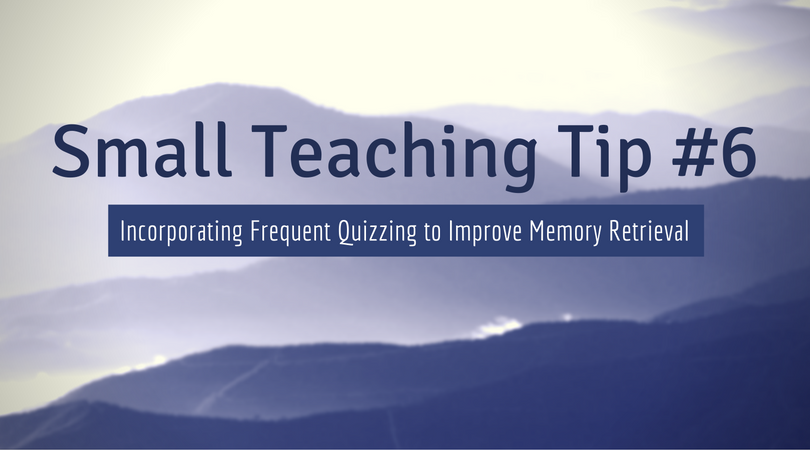In a previous post, I discussed the important role memory retrieval plays in learning. To briefly review: each time we recall a piece of information, we strengthen the neural pathways that move the information from our long-term memories to our working memories. So the more times we retrieve the information, the more deeply we learn it. This is known as the “testing effect.”
There are numerous ways to encourage students to practice memory retrieval, but one of the best strategies is frequent quizzing.
Tips for Frequent Quizzing
While quizzing is an effective method to practice memory retrieval, not all quizzes are created equal. There are a few empirically-tested stipulations that must be considered:
- First, make the quizzes count towards the course grade. While we would love our students to complete quizzes simply for the joy of learning, most require extra incentive. That being said, the quizzes should be relatively low-stakes. The purpose of these quizzes is to practice retrieval, not to have an anxiety attack each week.
- Second, avoid the pop quiz. Pop quizzes are only effective at intimidating students into coming to class. For most students, they do not encourage actual learning. But quizzes that students know about in advance do. Rest assured, these assessments do not need to be lengthy or require labor-intensive grading (there are countless instructional technologies that can help facilitate this process).
- Third, design quizzes to be at least partially cumulative. This requires students to reach back to concepts covered earlier in the term, developing deeper understanding and more complex mental models. Remember: greater retrieval efforts equal greater learning (note the emphasis on the word effort).
- Fourth, include question types that will be similar to what students can expect on exams. This allows students to familiarize themselves with those formats so the exam is a test of knowledge instead of exam-taking ability.
- Finally, occasionally assign quizzes that students complete before they learn new material. This may seem strange, but a pre-quiz encourages students to consult their previous knowledge to help them grapple with new ideas.
If you don’t have enough class time to devote to frequent quizzes, consider using online quizzes through OAKS. Most textbook publishers provide gigantic test banks that provide more than enough questions to create multiple quizzes throughout the semester. These banks are designed to be quickly imported into OAKS and quizzes can be automatically-graded, making quiz creation and administration simple. But to ensure students are practicing retrieval, restrict the time limit so they don’t have the leeway to look up every answer in their notes or book (20-50 seconds per multiple choice question is advisable).
Providing frequent opportunities for retrieval will not only help your students remember important information, it will also open the door to higher levels of cognition. I’ve shared one simple but powerful way to help your students learn that does not require an overwhelming amount of grading or extra preparation. Want more ideas? Check out the rest of our Small Teaching Tips series!
References
Roediger, H. L., Agarwal, P. K., McDaniel, M. A., & McDermott, K. (2011). Test-enhanced learning in the classroom: Long-term improvements from quizzing. Journal of Experimental Psychology: Applied, 17, 382-395.
Roediger, H. L., & Karpicke, J. D. (2006). The power of testing memory: Basic research and implications for educational practice. Perspectives on Psychological Science, 1, 181-210.
Leeming, F. C. (2002). The exam-a-day procedure improves performance in psychology classes. Teaching of Psychology, 29, 210-212.
Lyle, K. B., & Crawford, N. A. (2011). Retrieving essential material at the end of lectures improves performance on statistics exams. Teaching of Psychology, 38, 94-97.
Richland, L. E., Kornell, N., & Kao, L. S. (2009). The pretesting effect: Do unsuccessful retrieval attempts enhance learning? Journal of Experimental Psychology: Applied, 15, 243-257.
This post is part of a series which presents low risk, high reward teaching ideas, inspired by James Lang’s book Small Teaching: Everyday Lessons from the Science of Learning.











